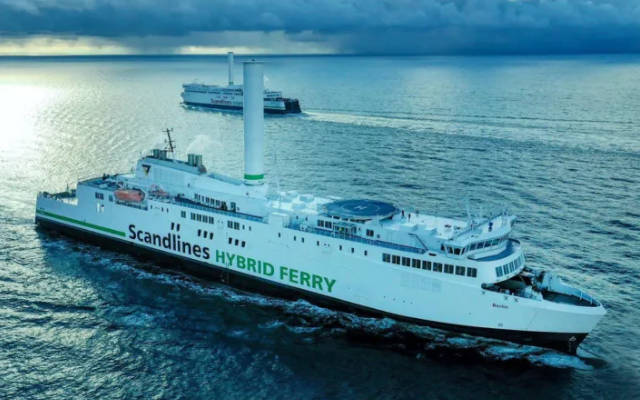Harnessing the Wind: Rotor Sails on Scandinavian Ferries

Strong cross winds on Scandlines' Denmark-to-Germany routes is ideal for its rotor sail ferries.
By EVWorld.com Si Editorial Team
A century-old idea is making waves in modern maritime transport. Scandinavian ferry operator Scandlines is leading the charge with its adoption of rotor sail technology - an innovative system that uses wind to reduce fuel consumption and carbon emissions on hybrid ferries. At the heart of this system is a deceptively simple yet powerful principle of physics: the Magnus effect.
Rotor sails, also known as Flettner rotors, are tall, spinning cylinders mounted vertically on a ship's deck. When wind flows across the rotating surface, it creates a pressure differential due to the Magnus effect - air accelerates on one side of the cylinder and slows on the other. This imbalance generates lift perpendicular to the wind direction, effectively pushing the ship forward like an invisible sail.
The lift generated by rotor sails is most effective under strong, steady crosswinds -when the wind blows perpendicular to the ship's direction of travel. In these conditions, the Magnus effect produces a forward thrust component that supplements the ship's propulsion system. If the wind is directly ahead (forward of the bow), the lift force is mostly lateral and does not contribute to forward motion. While traditional sailboats can be "caught in irons" under such headwind conditions - losing momentum and steerage - rotor sail vessels avoid this problem thanks to their hybrid propulsion systems. They simply revert to engine power when wind assistance is unavailable.
The direction in which the rotor spins is critical. To generate forward thrust, the rotor must spin so that the advancing side faces the wind. For example, if the wind is coming from starboard (the right side), the rotor spins clockwise when viewed from above. If the wind shifts to port, the motor reverses direction to maintain optimal lift. This adjustment is handled automatically by onboard sensors and control systems.
Today's rotor sails are a far cry from the steel prototypes of the 1920s. Companies like Norsepower, which supplies the sails for Scandlines, use lightweight composite materials such as carbon fiber and glass-reinforced plastics. These materials offer high strength-to-weight ratios, corrosion resistance, and durability in harsh marine environments. The rotors are powered by small electric motors, which require minimal energy - typically less than 1% of the ship's total power consumption.
The electric motor that spins the rotor sail draws power from the ship's onboard energy system. On Scandlines' hybrid ferries, this includes a combination of diesel engines and battery storage. The rotor sail's energy demand is modest, and the fuel savings it enables far outweigh the electricity it consumes.
Scandlines first installed a rotor sail on its hybrid ferry M/V Copenhagen in 2020, operating between Rostock, Germany and Gedser, Denmark. The results were impressive: average fuel savings of 4%, with reductions reaching up to 20% under optimal wind conditions. Encouraged by this success, the company added a second rotor sail to its sister ship, M/V Berlin, in 2022.
These savings translate directly into lower greenhouse gas emissions, supporting Scandlines' goal of becoming emission-free by 2040. The rotor sail is especially effective on routes with consistent crosswinds, like the Baltic Sea corridor used by these ferries.
The concept dates back to German engineer Anton Flettner, who first tested rotor sails on a ship in the 1920s. Though the idea was shelved for decades due to cheap fossil fuels, it has seen a resurgence in the 21st century as the maritime industry seeks sustainable alternatives.
With modern materials, smart automation, and growing environmental urgency, rotor sails are proving that sometimes, the best way forward is to spin back to the past - literally.
Original Backlink
Views: 116
Articles featured here are generated by supervised Synthetic Intelligence (AKA "Artificial Intelligence").
